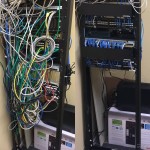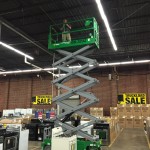Running Cat 5
The type of cable installed within your network is often referred to as network wiring. There are several types of cable used for network wiring such as category 5e, category 6, category 7 and fiber optics. The cabling is comprised of 8 individual wires, these wires are twisted together in pairs within the cable sheathing. These 4 pair of wires allow data to be processed and sent through the network at very fast speeds. Running Cat 5 cable is very similar to running Cat 6 cable with the exception that Cat 6 is heavier.
According to www.serverackandcable.com, the faster the speed and better the quality of cable and installation, the more data can flow from each device to the Internet. Bandwidth and the rate of data transfer are related to each other in the same way as a highway is related to traffic. Increasing the data transfer rate is similar to increasing the quantity of lanes on a thoroughfare to increase the traffic flow. It has been observed that the data rates increase by 100% every eighteen months and due to this there is a need to use new means of transmission with better transfer rates. Today the apps moving at a transfer rate of 1 Gb/sec are hitting the ceiling of category 5e cables capabilities. Applications which require streaming of data like video and multimedia transfer demand high transfer rates and this demand can only be fulfilled by Cat 6 network wiring and cables, which offer higher bandwidth. Use of Cat 6 will also boost the development of new applications which work with higher bandwidth.
If your office doesn't require fast data transfer, running Cat 5 or Cat 5e is a very good choice. Network jacks, cabling, patch panels, patch cords and other equipment used with Cat 5e cabling are less expensive when compared to Category 6 cabling. The termination of Cat 6 wiring takes longer and the testing is more strict. If you upgrade your network switch to Gigabit speeds, you may want to consider installing Cat 6 network wiring to allow the data to move as fast as the switch will process it. Hardware companies continue to introduce new equipment to the market that is faster and faster. Consider your use now and years down the road when installing your network cabling.
Category 6 cabling will provide a faster network speed when compared to running Cat 5 or Cat 5e. Category 6 cabling is a perfect choice when installing wireless access points or wireless routers. A streaming signal will benefit from the larger cable used to make Cat 6 cabling. The thicker the wire, the smaller the gauge. Cat 6 uses a larger copper wire to achieve the faster network speeds. Manufacturers specifications may vary, but on average you will find that Category 5e cable is 24 gauge and Category 6 cable is 23 gauge.

